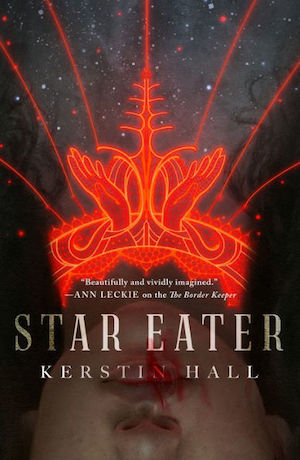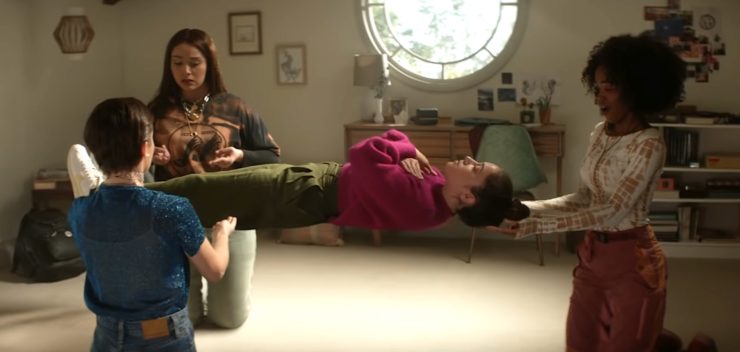1996’s The Craft became a beloved cult classic acknowledging that nearly every girl—or person raised as one—has gone through a “witch” phase. (Indeed, some never leave it.) But while the dangers of that film felt very real to your average American teenager, its ending was always an awkward thing that forewent the bonds of female fellowship and solidarity in favor of punishing one of their own for overstepping with her power.
Blumhouse’s sequel, The Craft: Legacy, was poised to be an answer to that error, a chance to show what young women can truly accomplish when they trust in each other. Sadly, the film is being dragged in far too many directions to answer for a decades-long slight.
The film centers on Lily (Cailee Spaeny), who moves with her mother Helen (Michelle Monaghan) to live with mom’s new boyfriend Adam Harrison (David Duchovny) and his three teenaged sons. Adam is a motivational speaker, the sort who is helping men discover The Hallowed Masculine (the name of one of his books), and raising his sons very strictly in their half-a-Brady-Bunch household. On her first day at a new school, Lily is openly mocked for getting her period in class, and on rushing to the bathroom, she makes three new friends: Frankie (Gideon Adlon), Tabby (Lovie Simone), and Lourdes (Zoey Luna). They are witches who form three parts of a coven, and on noting Lily’s innate abilities, they invite her to be their fourth member. It’s time to sit in a circle and call on the powers of the elements to activate their true potential as a group.
So far, so familiar. The girls have a montage of incantations and magic, bonding and laughing and having a grand old time together. They also cast a spell on one of the school’s worst bullies, Timmy Andrews (Nicholas Galitzine), in order to help him be a better person. This results in a profound personality shift that the girls refer to as “Woke Timmy”, morphing him into a boy who enjoys spending time with them as friends, who tells other boys to stop when they’re being inappropriate during sex ed class, who goes to parties as the sober driver and helps in the kitchen and puts Princess Nokia on his playlists. And while Galitzine’s performance also shifts into something profound and heartbreaking as the film goes on, it still begs a question: Why is a film that is meant to center on female bonds and empowerment, on witches and covens and magic, focusing so much on the stories of men?
It’s important to highlight this issue because it’s a point of confusion all the way through the film. This is a movie about witches. This is a movie about teenage girls. This is a movie that should be about what it feels like to be a young woman navigating our current world. But every time the film comes close to really delving in to those issues, there’s a male character who immediately shows up to pull focus. Even Lily’s mother Helen doesn’t get her due because every time their relationship gets breathing room, Duchovny is lurking just out of frame. (Is there a reason for that? Yes. Does it improve the film by leaps and bounds? Certainly not.) And this problem is further perpetuated by the fact that there are simply too many characters vying for screentime. You’ve got the coven, and Helen, and Adam, and his three boys, and Timmy, and some mean girls at school, and there’s just no way to focus on so many people without sacrificing something in the story… which turns out to be the coven itself.
Watching the coven together is truly the highlight of the film, making their lack of screen time that much more perplexing. The point where the girls explain witchcraft to Lily is easily the best scene of the entire film, fun and dynamic and flirtatious in the way that teenage girls genuinely are with one another. Their request to Lily to join the group—with Frankie down on one knee, proposing to her—is the realest piece of female bonding we get, and that’s before they’re even a coven yet. The film needed to amp up from that point, but instead it treats their chemistry as a given and walks away from it. The movie is clearly banking on its audience’s knowledge of the first film, which is itself a cheat—audiences may have watched the other coven do magic, but it’s not the just magic that we’re in it for. We need to get to know these four girls, their quirks and commonalities and idiosyncrasies that make them into such a powerful quartet.
Much in this film goes unexplained, to the point where it feels like chunks of the script went missing. We never find out how Helen met Adam, or why she decided to pack up her life and move her daughter into a strange house full of men she’s never met. We never find out what Lily’s life was like before arriving in this town, what sort of experiences she had elsewhere. We learn at one point that Adam’s eldest son Isaiah sleepwalks, which happens once, and then is never commented upon again. At one point, Lily talks to youngest son Abe, who seems to be on the brink of confiding in her, but nothing ever surfaces. We never find out who washed Lily’s bloodied jeans from school, though her discomfort at not knowing who handled them is highlighted pointedly. We find out that Lourdes is a trans girl, and while it’s wonderful to see a film like this making a much-needed space for transness in its definition of womanhood, the fact that Lourdes gets so little focus within the story makes it hard not to feel as though she’s being treated as a token, much in the way that Rachel True’s Rochelle was treated in the original. These are just a few threads the film leaves hanging, by the way—there are so many more, making the actual plot a difficult thing to parse at times.
Buy the Book


Star Eater
The film’s entire denouement goes largely unseen as well, which makes it impossible to fully enjoy the ending. We know that Lily’s mother is “tied up”, but we never see her get untied; we know that the girls have forgiven each other for their infractions, but we never truly see them talk or make up; we know that decisions have been made regarding Lily’s future, but we don’t know how they were arrived at. It’s so off-putting that it seems like three or four scenes of reconciliation and pointed discussion were accidentally deleted—or it would feel that way were the entire movie not mired with the same problem. The film ends on an abrupt tease, likely intended to set us up for a third installment, but only leaving us unsatisfied with a taste of what could have been.
There appear to be three different arcs that Legacy is trying to pull off: One centers on Lily and her hazy past, one on how this new coven is going to navigate the trials of trust and consent that the previous generation seemingly botched, and another is an arc dedicated to the concept of male magic, and how it is inherently cruel and malevolent. Which is a strange tack to take because the conceit of The Craft and stories about witchcraft in general do not require the presence of male magic to function. It ends up reading as though, in order to prevent the coven from turning on each other permanently as they did in the original, the creative team decided the girls needed a different antagonist to push back against. And in that search for an alternate power to fight against, the immediate thought was “Men!” and absolutely nothing further. It’s as lazy as it is puzzling, unfortunately, and since the film has no interest whatsoever in explaining its choices, we never learn why this route was deemed suitable for general antagonism.
So The Craft: Legacy never quite lives up to its promise. It’s distressing because there is a lot of charm between its frames, working hard to wriggle its way out and steal a little sun. And the film does work hard to address what the original got sideways, which is perhaps the saddest fact of all—while this movie turns sharply against the concept of punishing your sisters for their mistakes, it does so without due emotion and resonance. We don’t get to revel in the change because there’s nothing to see. All we get is some sparkle, a little chanting, and a great big fire to watch it all burn.
The Craft: Legacy is available now on VOD streaming platforms.
Emmet Asher-Perrin is going to form their own coven and cast a spell that gives us a new Craft film full of magic montages and Kristen Stewart jokes. You can bug them on Twitter, and read more of their work here and elsewhere.











The men in the craft all the whole 2006 covant movie about warlocks,and the whole willing your power to him is from the covanant,I though that Lily was gonna be Nancy daughter cause the olny born witch in the craft original.